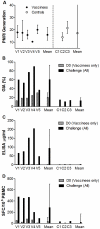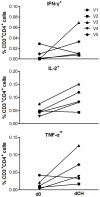Impact on malaria parasite multiplication rates in infected volunteers of the protein-in-adjuvant vaccine AMA1-C1/Alhydrogel+CPG 7909
- PMID: 21799809
- PMCID: PMC3142129
- DOI: 10.1371/journal.pone.0022271
Impact on malaria parasite multiplication rates in infected volunteers of the protein-in-adjuvant vaccine AMA1-C1/Alhydrogel+CPG 7909
Abstract
Background: Inhibition of parasite growth is a major objective of blood-stage malaria vaccines. The in vitro assay of parasite growth inhibitory activity (GIA) is widely used as a surrogate marker for malaria vaccine efficacy in the down-selection of candidate blood-stage vaccines. Here we report the first study to examine the relationship between in vivo Plasmodium falciparum growth rates and in vitro GIA in humans experimentally infected with blood-stage malaria.
Methods: In this phase I/IIa open-label clinical trial five healthy malaria-naive volunteers were immunised with AMA1/C1-Alhydrogel+CPG 7909, and together with three unvaccinated controls were challenged by intravenous inoculation of P. falciparum infected erythrocytes.
Results: A significant correlation was observed between parasite multiplication rate in 48 hours (PMR) and both vaccine-induced growth-inhibitory activity (Pearson r = -0.93 [95% CI: -1.0, -0.27] P = 0.02) and AMA1 antibody titres in the vaccine group (Pearson r = -0.93 [95% CI: -0.99, -0.25] P = 0.02). However immunisation failed to reduce overall mean PMR in the vaccine group in comparison to the controls (vaccinee 16 fold [95% CI: 12, 22], control 17 fold [CI: 0, 65] P = 0.70). Therefore no impact on pre-patent period was observed (vaccine group median 8.5 days [range 7.5-9], control group median 9 days [range 7-9]).
Conclusions: Despite the first observation in human experimental malaria infection of a significant association between vaccine-induced in vitro growth inhibitory activity and in vivo parasite multiplication rate, this did not translate into any observable clinically relevant vaccine effect in this small group of volunteers.
Trial registration: ClinicalTrials.gov [NCT00984763].
Conflict of interest statement
Figures








Similar articles
-
Phase 1 study in malaria naïve adults of BSAM2/Alhydrogel®+CPG 7909, a blood stage vaccine against P. falciparum malaria.PLoS One. 2012;7(10):e46094. doi: 10.1371/journal.pone.0046094. Epub 2012 Oct 4. PLoS One. 2012. PMID: 23056238 Free PMC article. Clinical Trial.
-
Phase 1 trial of AMA1-C1/Alhydrogel plus CPG 7909: an asexual blood-stage vaccine for Plasmodium falciparum malaria.PLoS One. 2008 Aug 13;3(8):e2940. doi: 10.1371/journal.pone.0002940. PLoS One. 2008. PMID: 18698359 Free PMC article. Clinical Trial.
-
A randomized and controlled Phase 1 study of the safety and immunogenicity of the AMA1-C1/Alhydrogel + CPG 7909 vaccine for Plasmodium falciparum malaria in semi-immune Malian adults.Vaccine. 2009 Dec 9;27(52):7292-8. doi: 10.1016/j.vaccine.2009.10.087. Epub 2009 Oct 27. Vaccine. 2009. PMID: 19874925 Free PMC article. Clinical Trial.
-
Can growth inhibition assays (GIA) predict blood-stage malaria vaccine efficacy?Hum Vaccin Immunother. 2012 Jun;8(6):706-14. doi: 10.4161/hv.19712. Epub 2012 Apr 20. Hum Vaccin Immunother. 2012. PMID: 22508415 Free PMC article. Review.
-
Paths to a malaria vaccine illuminated by parasite genomics.Trends Genet. 2015 Feb;31(2):97-107. doi: 10.1016/j.tig.2014.12.005. Epub 2015 Jan 22. Trends Genet. 2015. PMID: 25620796 Free PMC article. Review.
Cited by
-
Bliss' and Loewe's additive and synergistic effects in Plasmodium falciparum growth inhibition by AMA1-RON2L, RH5, RIPR and CyRPA antibody combinations.Sci Rep. 2020 Jul 16;10(1):11802. doi: 10.1038/s41598-020-67877-8. Sci Rep. 2020. PMID: 32678144 Free PMC article.
-
Phase 1 study in malaria naïve adults of BSAM2/Alhydrogel®+CPG 7909, a blood stage vaccine against P. falciparum malaria.PLoS One. 2012;7(10):e46094. doi: 10.1371/journal.pone.0046094. Epub 2012 Oct 4. PLoS One. 2012. PMID: 23056238 Free PMC article. Clinical Trial.
-
Progress with viral vectored malaria vaccines: A multi-stage approach involving "unnatural immunity".Vaccine. 2015 Dec 22;33(52):7444-51. doi: 10.1016/j.vaccine.2015.09.094. Epub 2015 Oct 21. Vaccine. 2015. PMID: 26476366 Free PMC article. Review.
-
Neutropenia as an Adverse Event following Vaccination: Results from Randomized Clinical Trials in Healthy Adults and Systematic Review.PLoS One. 2016 Aug 4;11(8):e0157385. doi: 10.1371/journal.pone.0157385. eCollection 2016. PLoS One. 2016. PMID: 27490698 Free PMC article.
-
Enhancing blockade of Plasmodium falciparum erythrocyte invasion: assessing combinations of antibodies against PfRH5 and other merozoite antigens.PLoS Pathog. 2012;8(11):e1002991. doi: 10.1371/journal.ppat.1002991. Epub 2012 Nov 8. PLoS Pathog. 2012. PMID: 23144611 Free PMC article.
References
-
- Roberts L, Enserink M. Malaria. Did they really say … eradication? Science. 2007;318:1544–1545. - PubMed
-
- Plowe CV, Alonso P, Hoffman SL. The potential role of vaccines in the elimination of falciparum malaria and the eventual eradication of malaria. J Infect Dis. 2009;200:1646–1649. - PubMed
-
- Goodman AL, Draper SJ. Blood-stage malaria vaccines - recent progress and future challenges. Ann Trop Med Parasitol. 104:189–211. - PubMed
Publication types
MeSH terms
Substances
Associated data
Grants and funding
LinkOut - more resources
Full Text Sources
Medical

